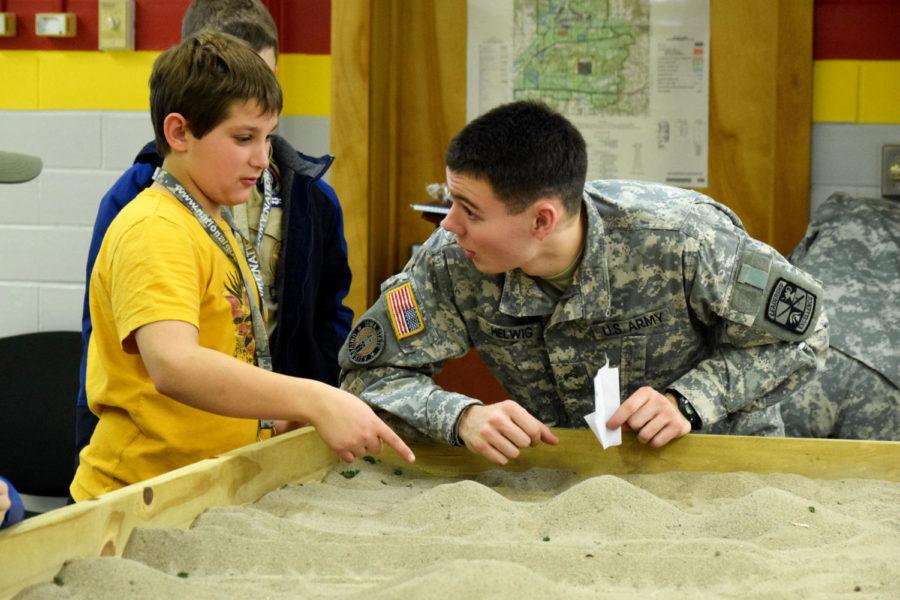AROTC cadets train scouts survival skills
An AROTC cadet goes over land navigation techniques with a Boy Scout at their annual Boy Scout Winter Survival training. Starting at 8 a.m., 280 scouts and 60 cadets worked on land navigation skills, fire building techniques, and other survival skill sets.
January 25, 2016
An Iowa winter hides for no one.
About 60 Army ROTC cadets led a training over the weekend that would help Mid-Iowa Council Boy Scouts gain more knowledge about what it means to be a scout, and of course, how to survive if you’re stranded outside in the winter.
About eight Boy Scout troops with 280 boys from around the district gathered in the Armory to go through eight different courses that would consider ways to survive in the elements at the 25th annual Boy Scout Winter Survival. It began at 8 a.m. Saturday and lasted until 4 p.m.
These courses included four indoor-classroom trainings that went over first aid, emergency signaling techniques, land navigation and personal hygiene in the field.
The four outdoor trainings, which took place in Pammel Woods just outside the Armory, included fire building, shelter construction, water purification techniques and how to snare, cook and track food.
Cadet Hayden Ford, senior in aerospace engineering, a former Eagle Scout who was in charge of planning and coordinating the event, spoke a little on why he feels doing this is important.
“It’s just a way to give back to the group that gave me such a good start, [they] made me who I am really,” Ford said. “They taught me an immense amount of skills that I wouldn’t have learned in school.”
Working with younger boys in elementary school all the way to high school Eagle Scouts, the survival training allows the ROTC cadets to act as leaders and hopefully give the boys something to look up to.
“Boy Scouts was originally created as a pathway into the military,” Ford said. “Obviously it’s changed quite a bit, but that link, I think is really important and just having that connection with the community.”
Cadet Matthew Kelly, junior in chemistry, was also a former Eagle Scout from Ankeny, Iowa, who had even participated in the training as a Scout, before helping lead it as a cadet.
“I participated in this when I was in Boy Scouts, and I did other survival classes, too,” Kelly said. “So it’s good to be able to relay that knowledge and carry on and use my knowledge to teach others.”
Steve Townsend, who has participated in the training for the past 11 years, acts as a middle-man between the troops and cadets.
He jokingly said that his job is pretty easy because the cadets take care of it all.
Townsend used to be a troop leader before working for the Boy Scouts district. He remembers one of his old troops being as big as 86 scouts.
“It gives them the ability to do things on their own outside,” Townsend said. “I mean, if you looked at some of the things that happened when the boys get out in the wilderness and they get stuck out there …”
He initially became a troop leader because his son, Stephen, wanted to join Boy Scouts. His son would go on to be in the Navy ROTC unit for a couple of years.
Events like these help the cadets reinforce their relationships with the community, along with teaching cadets of their own how to be a leader.
“I think, not only is it important obviously for the knowledge and the learning in the classes, but also because they get to see us. And a lot of kids look up to us in our uniforms, they look up to us as role models,” Kelly said. “It gives them a motivation and something to look up to.”

















